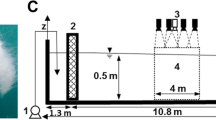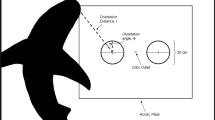Synopsis
Fishes producing high-frequency wavelike electrical discharges maintain a relatively rigid body axis and swim forwards and backwards with equal ease. Using stop-action videotape filming we have observed the gymnotiform Apteronotus albifrons feeding on zooplankton and oligochaete annelids. Here it is reported that reverse swimming is characteristic of two foraging behaviors: searching for prey and assessing it. In assessing a potential prey item, fish typically scan it from tail to head by swimming backwards, then ingest it after a short forward lunge. A scan in the opposite direction-from head to tail by forward swimming-would have the prey located near the tail and out of position for the final lunge. Food choice experiments indicate that these electrosensing fish feed equally well, and take larger rather than smaller zooplankton, under light and dark conditions. Furthermore, electric fish take normal (light) colored and darkened prey (Daphnia) in a 50: 50 ratio under both dark and light conditions. These results are consistent with the interpretation that electrosensory cues are being used to detect zooplankton and other prey. Together, our observations support Lissmann's (1958, 1974) and Lissmann & Machin's (1958) assertion that backwards swimming is a component of a locomotory pattern guided by the constraints produced by an active electrical sense.
Similar content being viewed by others
References cited
Bastian, J. 1975a. Receptive fields of cerebellar cells receiving exteroceptive input in a gymnotoid fish. Neurophysiol. 38: 285–300.
Bastian, J. 1975b. The range of electrolocation: a comparison of electromotor responses and the responses of cerebellar neurons in a gymnotoid fish. J. Comp. Physiol. 108: 193–210.
Bastian, J. 1981a. Electrolocation I: an analysis of the effects of moving objects and other electrical stimuli on the electroreceptor activity of Apteronotus albifrons. J. Comp. Physiol. 144: 465–479.
Bastian, J. 1981b. Electrolocation 11. The effects of moving objects and other electrical stimuli on the activities of two categories of posterior lateral line lobe cells in Apteronotus albifrons. J. Comp. Physiol. 144: 481–494.
Belbenoit, P. 1970. Conditionnement instrumental de l'electro-reception chez Gnathonemus petersii. Z. Vergl. Physiol. 67: 192–204.
Blake, R.W. 1983. Swimming in the electric eels and knifefishes. Can. J. Zool. 61: 1432–1441.
Breder, C.M. 1926. The locomotion of fishes. Zoologica (N.Y.) 4: 159–297.
Brooks, J.L. & S.I. Dodson. 1965. Predation, body size, and composition of plankton. Science 150: 28–35.
Bullock, T.H., D.A. Bodznick & R.G. Northcutt. 1983. The phylogenetic distribution of electroreception: evidence for convergent evolution of a primitive sense modality. Brain Res. 6: 35–46.
Bullock, T.H. & R.G. Northcutt. 1982. A new electroreceptive teleost: Xynomystus nigri (Osteoglossiformes: Notopteridae). J. Comp. Physiol. 148: 345–352.
Bullock, T.H. & T. Szabo, 1986. Introduction. pp. 1–12. In: T.H. Bullock & W. Heiligenberg (ed.) Electroreception, Wiley Interscience, New York.
Ehlinger, T.J. & D.S. Wilson. 1988. Complex foraging polymorphism in bluegill sunfish. Proc. Natl. Acad. Sci. USA 85: 1878–1882.
Ellis, M.M. 1913. The gymnotid eels of tropical America. Mem. Carnegie Mus. 6: 109–195.
Erskine, F.T., D.W. Howe & B.C. Weed. 1966. The discharge period of the weakly electric fish Sternarchus albifrons. Amer. Zool. 6: 521.
Finger, T.E., C.C. Bell & C.E. Carr. 1986. Comparisons among electroreceptive teleosts. Why are electrosensory systems so similar? pp. 465–481. In: T.H. Bullock & W. Heiligenberg (ed.) Electroreception, Wiley Interscience, New York.
Hagedorn, M. 1986. The ecology, courtship, and mating of gymnotiform electric fish. pp. 497–525. In: T.H. Bullock & W. Heiligenberg (ed.) Electroreception, Wiley Interscience, New York.
Heiligenberg, W. 1973. Electrolocation of objects in the electric fish Eigenmannia (Rhamphichthyidae, Gymnotoidei). J. Comp. Physiol. 87: 137–164.
Heiligenberg, W. 1975. Theoretical and experimental approaches to spatial aspects of electrolocation. J. Comp. Physiol. 103: 247–272.
Hopkins, C.D. 1976. Stimulus filtering and electroreception: tuberous electroreceptors in three species of gymnotoid fish. J. Comp. Physiol. 111: 171–207.
Hoshimiya, N., K. Shogen, T. Matsuo & S. Chichibu. 1980. The Apteronotus EOD field: waveform and EOD field simulation. J. Comp. Physiol. 135: 283–290.
Janssen, J. 1982. Comparison of searching behavior for zooplankton in an obligate planktivore, blueback herring (Alosa aestivalis) and a facultative planktivore, bluegill (Lepomis machrochirus). Can. J. Fish. Aquat. Sci. 39: 1649–1654.
Knoppell, H.A. 1970. Food of Amazonian fishes. Contribution to the nutrient-ecology of Amazonian rain-forest-streams. Amazonia 2: 257–352.
Krebs, C.J. 1989. Ecological methodology. Harper and Row, New York, 654 pp.
Lannoo, M.J. 1986. Vision is not necessary for size-selective zooplanktivory in aquatic vertebrates. Can. J. Zool. 64: 1071–1075.
Lannoo, M.J. & S.J. Lannoo. 1990. Why do electric fish swim backwards? An hypothesis based on foraging behavior. Amer. Zool. 30: 107A.
Lauder, G.V. 1985. Aquatic feeding in lower vertebrates. pp. 210–229. In: M. Hildebrand, D.M. Bramble, K.F. Liem & D.B. Wake (ed.) Functional Vertebrate Morphology, Belknap, Cambridge.
Lissmann, H.W. 1951. Continuous electrical signals from the tail of a fish, Gymnarchus niloticus Cuv. Nature 167: 201.
Lissmann, H.W. 1958. On the function and evolution of electric organs in fish. J. Exp. Biol. 35: 156–191.
Lissmann, H.W., 1974. Electric location by fishes. pp. 56–65. In: Animal Engineering, Readings from Scientific American, From original article published in March, 1963 (208: 50–59), W.H. Freeman and Co., San Francisco.
Lissmann, H.W. & K.E. Machin 1958. The mechanisms of object location in Gymnarchus niloticus and similar fish. J. Exp. Biol. 35: 451–486.
Mago-Leccia, F. & T.M. Zaret. 1978. The taxonomic status of Rhabdolichops troscheli (Kaup, 1856), and speculations on gymnotiform evolution. Env. Biol. Fish. 3: 379–384.
Manly, B.F.J., P. Miller & L.M. Cook. 1972. Analysis of a selective predation experiment. Amer. Nat. 106: 719–736.
Steinbach, A.B. 1970. Diurnal movements and discharge characteristics of electric gymnotid fishes in the Rio Negro. Brazil Biol. Bull. 138: 200–210.
Toerring, M.J. & P. Belbenoit. 1979. Motor programmes and electroreception in mormyrid fish. Behav. Ecol. Sociobiol. 4: 369–379.
Vinyard, G.L. & W.J. O'Brien. 1976. Effects of light and turbidity on the reactive distance of bluegill (Lepomis macrochirus). J. Fish. Res. Board Can. 33: 2845–2849.
von der Emde, G. 1990. Discrimination of objects through electrolocation in the weakly electric fish, Gnathonemus petersii. J. Comp. Physiol. 167: 413–421.
Werner, E.E. & D.J. Hall. 1974. Optimal foraging and the size selection of prey by the bluegill sunfish (Lepomis macrochirus). Ecology 55: 1042–1052.
Zaret, T.M. 1979. Predation and freshwater communities. Yale University Press, New Haven, 187 pp.
Author information
Authors and Affiliations
Rights and permissions
About this article
Cite this article
Lannoo, M.J., Lannoo, S.J. Why do electric fishes swim backwards? An hypothesis based on gymnotiform foraging behavior interpreted through sensory constraints. Environ Biol Fish 36, 157–165 (1993). https://doi.org/10.1007/BF00002795
Received:
Accepted:
Issue Date:
DOI: https://doi.org/10.1007/BF00002795




